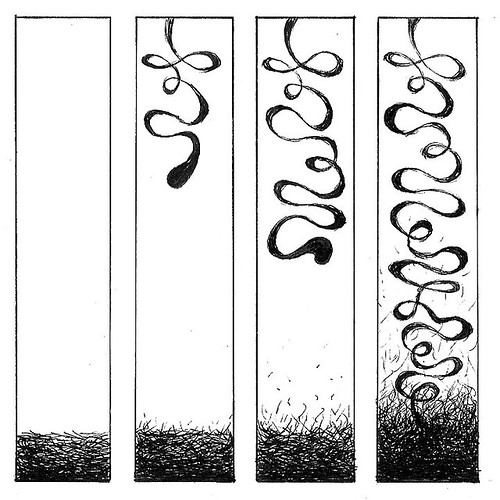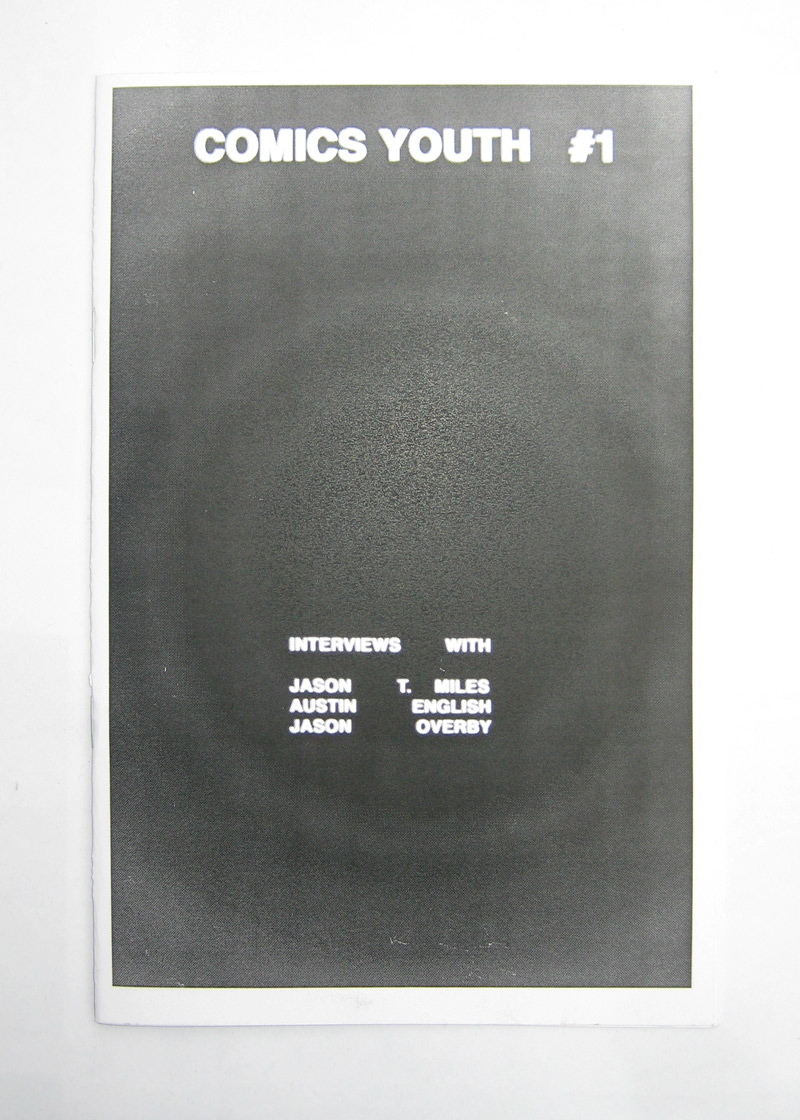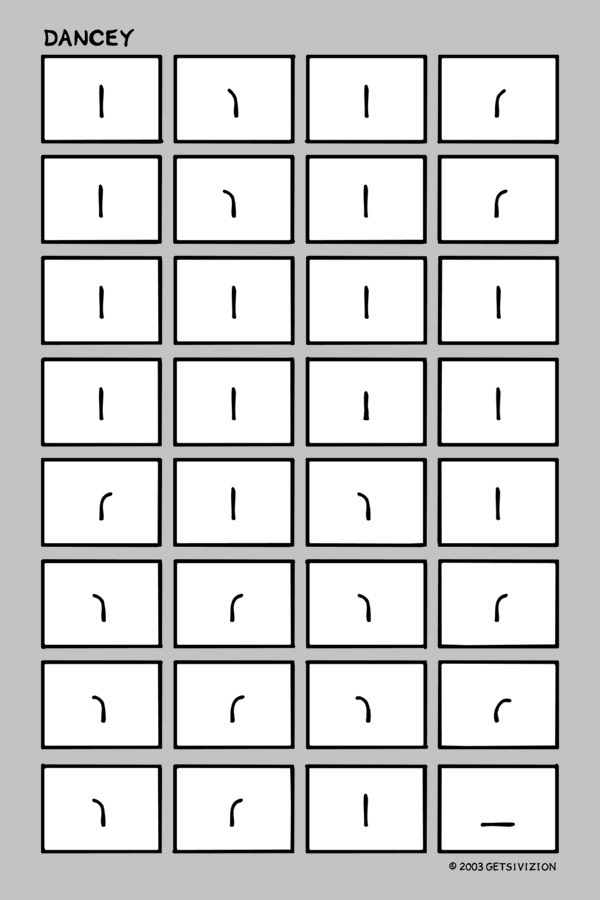Here's an abstract comic; quick, who is it by?

Ok, ok, I know this won't work
twice in a row, not to mention I already gave away the answer in the title to this post. Here is the page from "Understanding Comics" from which the above comes:

(It's page 137, the last page of chapter 5, "Living in Line.")
Scott was here in Bloomington this past Monday, giving an amazing talk to the largest and most enthusiastic audience I've ever seen at a university lecture; I fortunately had the chance to hang out with him both before and after his talk, and I'm still pumped up about all the artistic and technological possibilities we batted back and forth (and also with seven PhD students from Computer Science, over dinner!). (Scott was also kind enough to
link on his blog to my earlier post on
Understanding Comics and
Zot, and I'd like hereby to thank him for both that and for his visit.)
Anyway, since that post, I have kept going back to
Understanding Comics, and realizing more and more not only how extensive is the presence of abstraction in its overall argument, but also how
UC itself opens up a space for the possibility, and reception, of abstract comics. To begin with, notice that McCloud's definition of comics says nothing about narrative or figuration:

Secondly, after discussing "iconic abstraction," the simplification inherent in cartooning that may reduce figures to very simple shapes which nevertheless still have meaning (this is something that I also mentioned, probably remembering this passage from
UC, in the introduction to the anthology), McCloud goes on to mention the more traditional sense of "abstraction," the one we largely use here:

To talk about "ink on paper" is to talk about the dissolution of diegesis, of representation; and that "it means what it is" seems to me to echo (unconsciously?) Frank Stella's "You see what you see." This, then, completely opens the possibility of abstract comics, which can occupy the top of McCloud triangular schema:

Now, as you will notice, once McCloud begins to fill up his triangle with examples, he actually does not have any that go all the way up to (non-iconic) abstraction. The highest-placed example in his schema is "Mary Fleener at her most abstract," but that is still fully iconic abstraction:

So, in a way, McCloud functions here like a nuclear physicist positing the theoretical possibility of a particle--or, in this case, a genre, a kind of comic--even before having any empirical proof of its existence. (I should add here that the anthology does contain some examples of pre-1994 fully abstract and non-iconic sequential art, but most of them had not been published at the time--such as McDonnell's, Badger's, or Joly's--or come from other media, such as painting or graphic design; given my expanded definition of abstract comics, I also included earlier work by Crumb or Zenick that does include representative elements, but clearly that's not what McCloud is talking about here.)
Abstraction, once you look for it, is present everywhere in
UC, as is the possibility of its being used for sequential-art purposes. Here are two example McCloud gives of non-sequitur panel-to-panel transitions:


(Come to think of it, it would be interesting to try such hybrid, figurative-to abstract-to-figurative comics.)
It is significant that abstraction is used specifically to illustrate the "non-sequitur" category of transitions. The previous five categories--moment-to-moment, action-to-action--clearly imply a fictional time ("moment"), represented actors and actions, etc. They are categories that only apply to traditionally narrative comics that construct a fictional diegesis (and, yes, even when such comics are based on fact, the diegesis is still fictional--think of "Maus"; but that's a discussion for another time.) In a way, the non-sequitur category is left to gather all (?) transitions featured in comics without such a diegesis; and it is our task, I would argue, to keep exploring that realm, and to try to understand all the possibilities inherent in it. (Including to study its apparent paradox, that of a "non-sequitur"--i.e., which does not follow--transition, in "sequential" art; and notice that "sequitur" and "sequence" derive from the same root.)
The possibility of abstract comics is broached repeatedly when McCloud's examples tend toward the abstract:


(This last sequence, though not fully abstract, does address an important issue that many of us have been dealing with--and even using to our advantage--in our abstract comics: when time is no longer clearly represented, how do you draw out a sequence from the abstract page layout? Do you even need to? Another question to be explored later.)
Even when not intended as such, some of McCloud's examples achieve a kind of formal sequencing that essentially turns them into abstract comics, or would do so if we were to remove the words; in this case, for example, the gradual multiplication of elements, together with the growing confusion of color, makes for a clear and simple sequencing principle:

There is one more way in which
UC opened the possibility of abstract comics--not only theoretically, but by confronting the fanboy or fangirl who had opened its pages, trying to understand how
The Dark Knight or
Jimmy Corrigan functioned, with the visual evidence of abstraction in comic panels. Just look at McCloud's chapter titles:

Look at his extensive use of examples of abstract art (thereby, I should add, expanding the art-historical perspectives of his readers):

Look again at his restatement, in the final chapter, of the wide range of possible rendering styles in comics, from the nearly photographic to the cartoony to...

And look at the backgrounds--clearly intended to be comic panels--on this page (part of
UC's conclusion) meant to celebrate the continuingly evolving language of comics:

Here we are, fifteen years in
UC's future, and some of the possibilities of evolution that McCloud predicted have taken place, some of them on this very blog; and quite possibly because of that very prediction.
Thanks, Scott!


 here's a page from Wilfried Hou Je Bek's translation of parts of the ancient Sumerian Epic of Gilgamesh into the pictograms used by ape researchers. (he had to invent new symbols for the characters Gilgamesh & Enkidu.)
here's a page from Wilfried Hou Je Bek's translation of parts of the ancient Sumerian Epic of Gilgamesh into the pictograms used by ape researchers. (he had to invent new symbols for the characters Gilgamesh & Enkidu.) Abstract 18 series 2 This is my first attempt at revisiting the process making these comics. I like the ambiguous role of the paint. Sometimes it functions as a gutter sometimes as a panel. Abstract 19 is another piece done with the same found image.
Abstract 18 series 2 This is my first attempt at revisiting the process making these comics. I like the ambiguous role of the paint. Sometimes it functions as a gutter sometimes as a panel. Abstract 19 is another piece done with the same found image.

 here's a visual poem, which I think was quoted at http://blogdogutemberg.blogspot.com/2007_03_01_archive.html on 12 Março 2007.
here's a visual poem, which I think was quoted at http://blogdogutemberg.blogspot.com/2007_03_01_archive.html on 12 Março 2007.


























